Blue sapphires have captivated humanity for centuries with their mesmerizing depth of color, making them one of the most coveted gemstones in the world of jewelry. Within the realm of blue sapphires, however, lies a spectrum of hues, each with its own unique charm and allure. In this article, we delve into the quest for the best blue sapphire color, exploring the intricacies of grading, quality factors, historical significance, geographical sources, and care and maintenance.
Color Grading: Deciphering the Spectrum
Color is arguably the most defining characteristic of a blue sapphire, and it plays a pivotal role in determining its value and desirability. The Gemological Institute of America (GIA) employs a comprehensive grading system to assess the color of sapphires, taking into account hue, tone, and saturation.
The most sought-after hue for blue sapphires is a rich, velvety blue to violet-blue, reminiscent of the azure skies on a clear summer day. This hue exudes a sense of depth and intensity, captivating the beholder with its timeless elegance. Sapphires in medium to medium-dark tones are particularly prized for their optimal balance of color saturation and brightness.
However, the presence of secondary colors can significantly impact a blue sapphire’s appeal and value. While traces of purple can enhance the gemstone’s allure, imparting a subtle hint of royalty, excessive violet undertones may detract from its purity. Similarly, greenish or grayish tints can diminish the vibrancy of the blue, resulting in a less desirable gemstone.
Quality Factors: Beyond Color
While color undoubtedly takes center stage, several other factors contribute to the overall quality and value of a blue sapphire. Clarity, cut, and carat weight play pivotal roles in enhancing the gemstone’s beauty and brilliance.
Clarity refers to the presence of internal flaws, known as inclusions, within the sapphire. Ideally, a high-quality blue sapphire should exhibit minimal inclusions, allowing light to pass through unhindered and showcasing its vibrant color to its full potential.
The cut of a blue sapphire is equally crucial, as it determines the gemstone’s proportions, symmetry, and facets. A well-executed cut can maximize the sapphire’s brilliance and fire, accentuating its color and clarity with precision.
Carat weight, while significant, is not the sole determinant of a blue sapphire’s value. A smaller sapphire of exceptional color and clarity may command a higher price than a larger stone with inferior characteristics.
Historical and Cultural Significance: A Legacy of Splendor
Throughout history, blue sapphires have held a place of reverence in various cultures and civilizations. In ancient times, they were believed to possess mystical powers, safeguarding their wearers from harm and bestowing blessings of wisdom and prosperity.
In many societies, blue sapphires symbolize loyalty, sincerity, and divine favor, making them popular choices for engagement rings and other meaningful jewelry pieces. The association with fidelity and enduring love has cemented their status as timeless symbols of devotion and commitment.
Geographical Sources: Unveiling Nature’s Treasures
High-quality blue sapphires are predominantly sourced from a handful of renowned regions known for their gemstone deposits. Among the most esteemed sources are Kashmir, Myanmar (Burma), and Sri Lanka (Ceylon), each renowned for producing sapphires of exceptional color and clarity.
Kashmiri sapphires, revered for their ethereal velvety blue hue, are among the rarest and most prized varieties in the world. Their unparalleled beauty is attributed to trace elements present in the region’s geological formations, which imbue the sapphires with their distinctive coloration.
Myanmar and Sri Lanka also boast rich deposits of blue sapphires, ranging from vivid cornflower blues to deep royal blues. These gemstones are treasured for their clarity and brilliance, often fetching premium prices in the global market.
Care and Maintenance: Preserving the Brilliance
To ensure that blue sapphire jewelry retains its luster and beauty for generations to come, proper care and maintenance are essential. Here are some tips to safeguard your prized possessions:
1. Regular Cleaning: Clean your blue sapphire jewelry with a soft brush and mild soapy water to remove dirt and residue. Avoid harsh chemicals and ultrasonic cleaners, as they can damage the gemstone.
2. Gentle Handling: Handle your blue sapphire jewelry with care to prevent accidental scratches or chips. Store them separately from other jewelry pieces to minimize friction and abrasion.
3. Avoid Exposure: Protect your blue sapphires from prolonged exposure to sunlight and heat, as excessive heat can cause fading and discoloration over time.
4. Professional Inspection: Schedule periodic inspections with a reputable jeweler to assess the condition of your blue sapphire jewelry and address any potential issues promptly.
By adhering to these simple guidelines, you can ensure that your blue sapphire jewelry remains a cherished heirloom, embodying the timeless allure of this captivating gemstone.
In conclusion, the quest for the best blue sapphire color is a journey fueled by a passion for beauty and excellence. Whether adorned in a stunning engagement ring or a statement necklace, blue sapphires continue to captivate hearts and minds with their celestial hues and enchanting allure, transcending time and culture with their timeless splendor.

